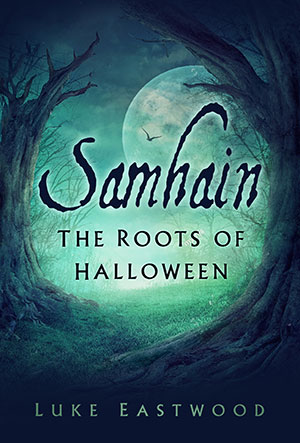 LUKE EASTWOOD
LUKE EASTWOOD
The History Press
€14.99
ISBN 9780750998000
Reviewed by Regina Sexton
To embrace a study of Ireland’s best-known and best-loved festival of Hallowe’en is no small undertaking. Overshadowing any attempt are seminal works of sound and extensive scholarship: Máire MacNeill’s The festival of Lughnasa (1962), Séamus Ó Catháin’s Festival of Brigit: Celtic goddess and holy woman (1995) and, more recently, Billy Mac Fhloinn’s Blood rite: the feast of St Martin in Ireland (2016). These exemplary publications, although academic in nature, serve as instructive guides illustrating ways of approaching the monumental subject of Hallowe’en. Aside from concerns of scholarship, Hallowe’en in the popular and populist mind is held to be a festival of Irish origin. Its reinvention in more recent times as a tourism commodity overlaps with its amplification in new religious movements and contemporary paganism. As a subject of study, Hallowe’en is vast, if not unwieldy.
Luke Eastwood’s publication, Samhain: the roots of Halloween, does more than the title suggests: its 137 pages consider Irish cosmology and the otherworld, the festival of Samhain and its evolution into Hallowe’en, and neo-pagan revivals of the festival, but the book’s main concentration is on Tlachtga, the Hill of Ward, in County Meath. This is not surprising, as the Late Bronze Age/Early Iron Age site is considered the birthplace of Hallowe’en in legend and in the folk mind. Accordingly, the monument’s ceremonial significance is discussed and linked to the mythological female character of Tlachtga and her father, the druid Mogh Ruith. Much of the discussion of Tlachtga, the female druidess, is undertaken with reference to her depiction in various later medieval texts. These are often reproduced as lengthy passages taken from existing translations of manuscripts such as the Book of Lismore and the Book of Ballymote, but there is no consideration of the manuscript tradition and the objectives behind their composition in the context of their time. As a ceremonial site, a description of its significance is based on the archaeological excavations undertaken between 2014 and 2016, and much of the material in this chapter is a summary of the archaeological reports. The chapter also attends to local traditions about the site, with extracts taken from the work of Michelle Alú’s ethnographic interview with local inhabitant Máiréad Byrd. This interview prompts Eastwood to seek out references to Tlachtga in the National Folklore Commission Schools’ Collection, and several contributions from informants are reproduced to expand the topic of superstitions and the site.
While Samhain: the roots of Halloween does not present itself as an academic exploration of the festival, it is nonetheless difficult to satisfactorily pin down the nature of this publication. It mixes history, folklore and mythology with the phenomenon of increased and increasing interest in new religions. This recent development is only lightly treated, which is unfortunate given the extent of existing research in the area. The book itself is commendably heavy in detail but lacking in any attempt at critical discussion. The overall impression is that it is a publication that collates the work of existing publications dealing directly or tangentially with the topic of Hallowe’en. Works that position themselves with the intention of drawing together existing scholarship to present a comprehensive overview of a topic can work exceedingly well in generating interest in a specific subject. When well done, they can encourage readers to delve further to expand and deepen their knowledge in that particular field. I’m afraid, however, that this publication may not result in that desired outcome.
While the book presents a lot of detail throughout its six chapters, it appears to lack a sense of cohesion and smooth flow-through from one subject to another and from one period to the next. As mentioned, it draws upon many disciplines and multiple sources of data, but a lack of mastery of disciplinary approaches and of a critical understanding of source materials tends to undermine its character and quality. This is very unfortunate, as the author has given time to extensive research and has brought together a body of very interesting material. This needs more careful attention in terms of ordering, structuring and discipline-specific insights. Overall, the impression created is that this is a work in progress rather than a work ready for publication. Missing, too, is biographical detail on the author.
On a more positive note, to select the topic of Hallowe’en is a very brave undertaking and a great deal of very interesting information is imparted in this book. Attention to the highly significant and important site of Tlachtga is very welcome, and an overview of its importance in the context of Hallowe’en makes for enjoyable reading. Welcome, too, is the intention of the book to dispel the notion that Hallowe’en is an Irish ‘invention’. Overall, Samhain: the roots of Halloween is a pleasant read with extensive detail, making it a very good introduction to the festival in Ireland, with some lovely complementary illustrations by Elena Danaan.
Regina Sexton is a culture, food and culinary historian and the Programme Manager of the Postgraduate Diploma in Irish Food Culture, University College Cork.
